Introduction to Emotional Development and Ageing Psychology Essay
VerifiedAdded on 2020/06/03
|9
|2644
|58
Essay
AI Summary
This essay delves into the intricate nature of emotional development, differentiating it across various stages of human ageing. It emphasizes the increasing complexity of emotional and psychological development with age, highlighting the body's adaptations to the external environment for survival. The essay underscores the significant roles of parents and caregivers in fostering strong bonds and social connections. It explores key psychological theories, including Bowlby's attachment theory, Darwin's theory of natural selection, Erickson's model, and the concept of comfort contact, to establish their relevance to the stages of development. The main body examines the emotional and psychological changes individuals experience during their developmental stages and discusses how these theories relate to psychophysical development and social behavior. It also explores the influence of genetics and environmental factors on emotional and psychophysical development. The essay concludes by emphasizing the interconnectedness of emotional and psychophysical changes throughout the lifespan, as evidenced by the theories discussed, and validating the hypothesis that psychophysical strategies play a crucial role in understanding emotional and psychological development across different life stages.
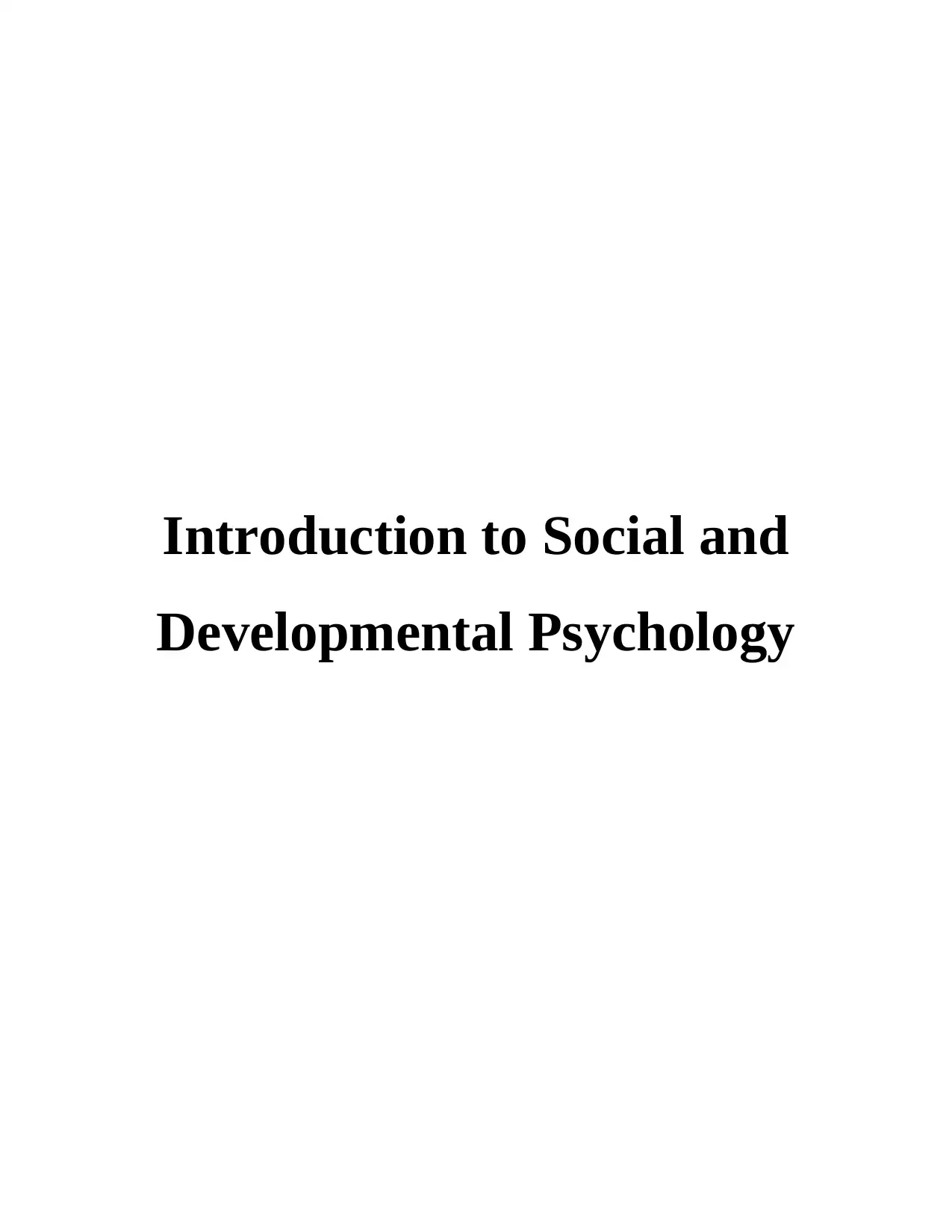
Introduction to Social and
Developmental Psychology
Developmental Psychology
Paraphrase This Document
Need a fresh take? Get an instant paraphrase of this document with our AI Paraphraser

Table of Contents
INTRODUCTION...........................................................................................................................1
MAIN BODY...................................................................................................................................1
CONCLUSION................................................................................................................................6
REFERENCES................................................................................................................................7
INTRODUCTION...........................................................................................................................1
MAIN BODY...................................................................................................................................1
CONCLUSION................................................................................................................................6
REFERENCES................................................................................................................................7
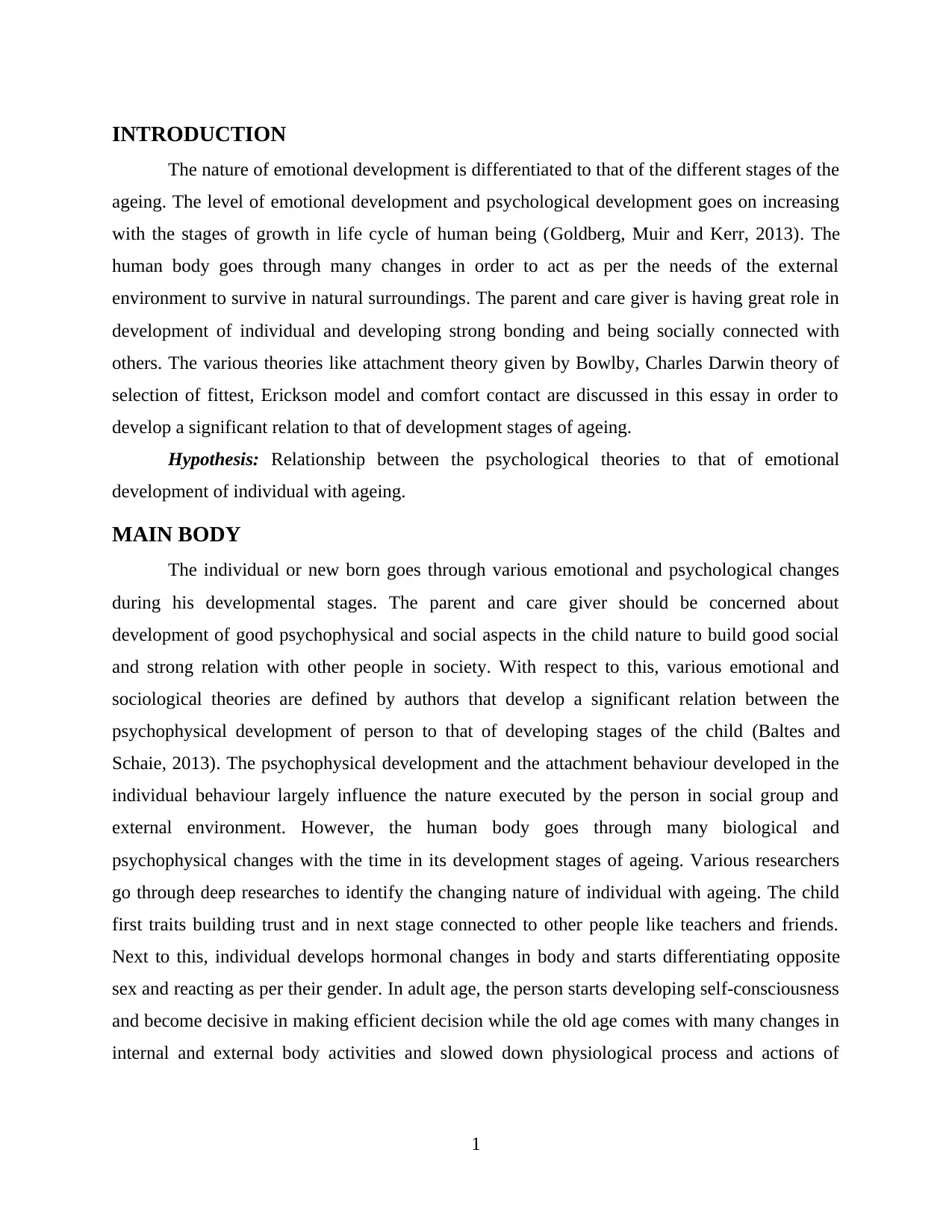
INTRODUCTION
The nature of emotional development is differentiated to that of the different stages of the
ageing. The level of emotional development and psychological development goes on increasing
with the stages of growth in life cycle of human being (Goldberg, Muir and Kerr, 2013). The
human body goes through many changes in order to act as per the needs of the external
environment to survive in natural surroundings. The parent and care giver is having great role in
development of individual and developing strong bonding and being socially connected with
others. The various theories like attachment theory given by Bowlby, Charles Darwin theory of
selection of fittest, Erickson model and comfort contact are discussed in this essay in order to
develop a significant relation to that of development stages of ageing.
Hypothesis: Relationship between the psychological theories to that of emotional
development of individual with ageing.
MAIN BODY
The individual or new born goes through various emotional and psychological changes
during his developmental stages. The parent and care giver should be concerned about
development of good psychophysical and social aspects in the child nature to build good social
and strong relation with other people in society. With respect to this, various emotional and
sociological theories are defined by authors that develop a significant relation between the
psychophysical development of person to that of developing stages of the child (Baltes and
Schaie, 2013). The psychophysical development and the attachment behaviour developed in the
individual behaviour largely influence the nature executed by the person in social group and
external environment. However, the human body goes through many biological and
psychophysical changes with the time in its development stages of ageing. Various researchers
go through deep researches to identify the changing nature of individual with ageing. The child
first traits building trust and in next stage connected to other people like teachers and friends.
Next to this, individual develops hormonal changes in body and starts differentiating opposite
sex and reacting as per their gender. In adult age, the person starts developing self-consciousness
and become decisive in making efficient decision while the old age comes with many changes in
internal and external body activities and slowed down physiological process and actions of
1
The nature of emotional development is differentiated to that of the different stages of the
ageing. The level of emotional development and psychological development goes on increasing
with the stages of growth in life cycle of human being (Goldberg, Muir and Kerr, 2013). The
human body goes through many changes in order to act as per the needs of the external
environment to survive in natural surroundings. The parent and care giver is having great role in
development of individual and developing strong bonding and being socially connected with
others. The various theories like attachment theory given by Bowlby, Charles Darwin theory of
selection of fittest, Erickson model and comfort contact are discussed in this essay in order to
develop a significant relation to that of development stages of ageing.
Hypothesis: Relationship between the psychological theories to that of emotional
development of individual with ageing.
MAIN BODY
The individual or new born goes through various emotional and psychological changes
during his developmental stages. The parent and care giver should be concerned about
development of good psychophysical and social aspects in the child nature to build good social
and strong relation with other people in society. With respect to this, various emotional and
sociological theories are defined by authors that develop a significant relation between the
psychophysical development of person to that of developing stages of the child (Baltes and
Schaie, 2013). The psychophysical development and the attachment behaviour developed in the
individual behaviour largely influence the nature executed by the person in social group and
external environment. However, the human body goes through many biological and
psychophysical changes with the time in its development stages of ageing. Various researchers
go through deep researches to identify the changing nature of individual with ageing. The child
first traits building trust and in next stage connected to other people like teachers and friends.
Next to this, individual develops hormonal changes in body and starts differentiating opposite
sex and reacting as per their gender. In adult age, the person starts developing self-consciousness
and become decisive in making efficient decision while the old age comes with many changes in
internal and external body activities and slowed down physiological process and actions of
1
You're viewing a preview
Unlock full access by subscribing today!
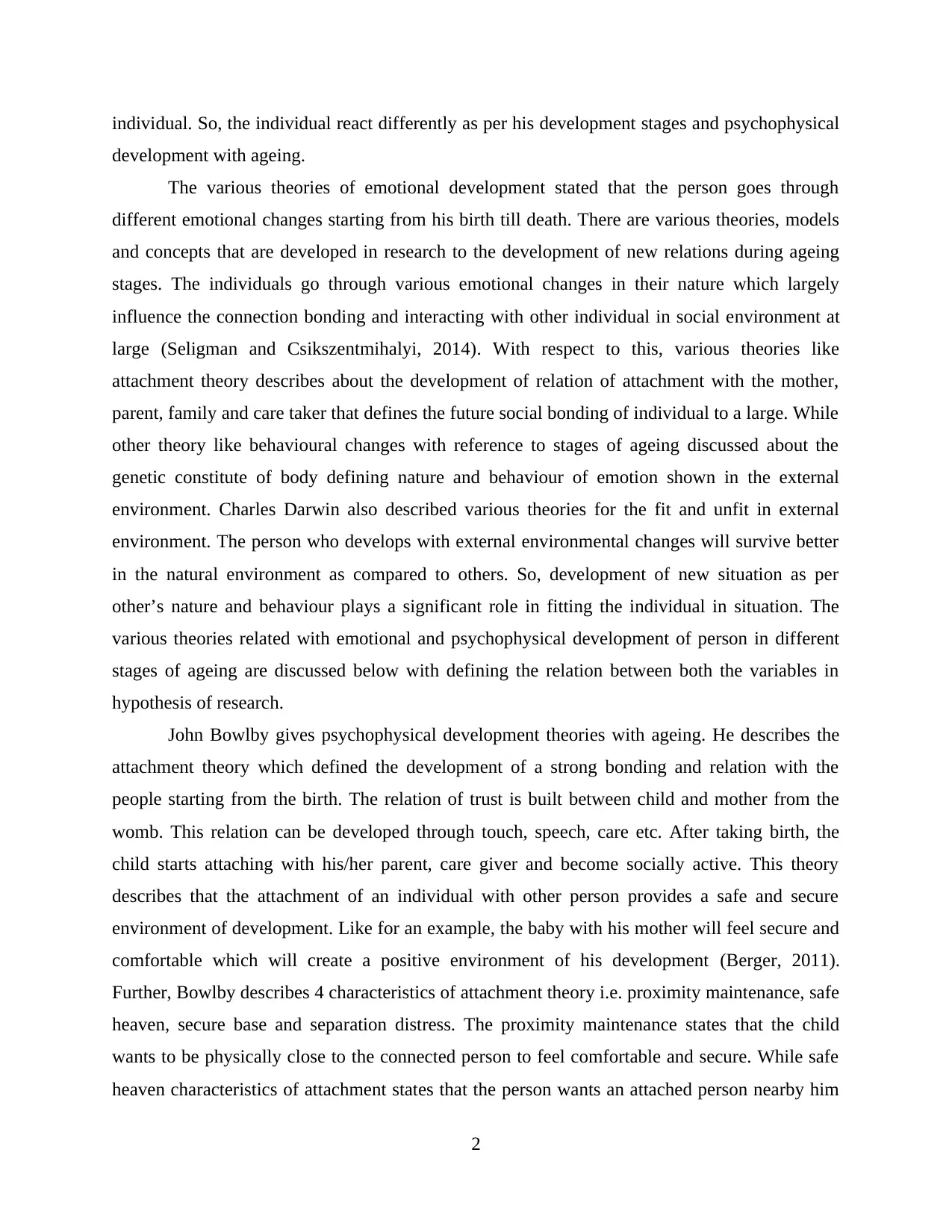
individual. So, the individual react differently as per his development stages and psychophysical
development with ageing.
The various theories of emotional development stated that the person goes through
different emotional changes starting from his birth till death. There are various theories, models
and concepts that are developed in research to the development of new relations during ageing
stages. The individuals go through various emotional changes in their nature which largely
influence the connection bonding and interacting with other individual in social environment at
large (Seligman and Csikszentmihalyi, 2014). With respect to this, various theories like
attachment theory describes about the development of relation of attachment with the mother,
parent, family and care taker that defines the future social bonding of individual to a large. While
other theory like behavioural changes with reference to stages of ageing discussed about the
genetic constitute of body defining nature and behaviour of emotion shown in the external
environment. Charles Darwin also described various theories for the fit and unfit in external
environment. The person who develops with external environmental changes will survive better
in the natural environment as compared to others. So, development of new situation as per
other’s nature and behaviour plays a significant role in fitting the individual in situation. The
various theories related with emotional and psychophysical development of person in different
stages of ageing are discussed below with defining the relation between both the variables in
hypothesis of research.
John Bowlby gives psychophysical development theories with ageing. He describes the
attachment theory which defined the development of a strong bonding and relation with the
people starting from the birth. The relation of trust is built between child and mother from the
womb. This relation can be developed through touch, speech, care etc. After taking birth, the
child starts attaching with his/her parent, care giver and become socially active. This theory
describes that the attachment of an individual with other person provides a safe and secure
environment of development. Like for an example, the baby with his mother will feel secure and
comfortable which will create a positive environment of his development (Berger, 2011).
Further, Bowlby describes 4 characteristics of attachment theory i.e. proximity maintenance, safe
heaven, secure base and separation distress. The proximity maintenance states that the child
wants to be physically close to the connected person to feel comfortable and secure. While safe
heaven characteristics of attachment states that the person wants an attached person nearby him
2
development with ageing.
The various theories of emotional development stated that the person goes through
different emotional changes starting from his birth till death. There are various theories, models
and concepts that are developed in research to the development of new relations during ageing
stages. The individuals go through various emotional changes in their nature which largely
influence the connection bonding and interacting with other individual in social environment at
large (Seligman and Csikszentmihalyi, 2014). With respect to this, various theories like
attachment theory describes about the development of relation of attachment with the mother,
parent, family and care taker that defines the future social bonding of individual to a large. While
other theory like behavioural changes with reference to stages of ageing discussed about the
genetic constitute of body defining nature and behaviour of emotion shown in the external
environment. Charles Darwin also described various theories for the fit and unfit in external
environment. The person who develops with external environmental changes will survive better
in the natural environment as compared to others. So, development of new situation as per
other’s nature and behaviour plays a significant role in fitting the individual in situation. The
various theories related with emotional and psychophysical development of person in different
stages of ageing are discussed below with defining the relation between both the variables in
hypothesis of research.
John Bowlby gives psychophysical development theories with ageing. He describes the
attachment theory which defined the development of a strong bonding and relation with the
people starting from the birth. The relation of trust is built between child and mother from the
womb. This relation can be developed through touch, speech, care etc. After taking birth, the
child starts attaching with his/her parent, care giver and become socially active. This theory
describes that the attachment of an individual with other person provides a safe and secure
environment of development. Like for an example, the baby with his mother will feel secure and
comfortable which will create a positive environment of his development (Berger, 2011).
Further, Bowlby describes 4 characteristics of attachment theory i.e. proximity maintenance, safe
heaven, secure base and separation distress. The proximity maintenance states that the child
wants to be physically close to the connected person to feel comfortable and secure. While safe
heaven characteristics of attachment states that the person wants an attached person nearby him
2
Paraphrase This Document
Need a fresh take? Get an instant paraphrase of this document with our AI Paraphraser
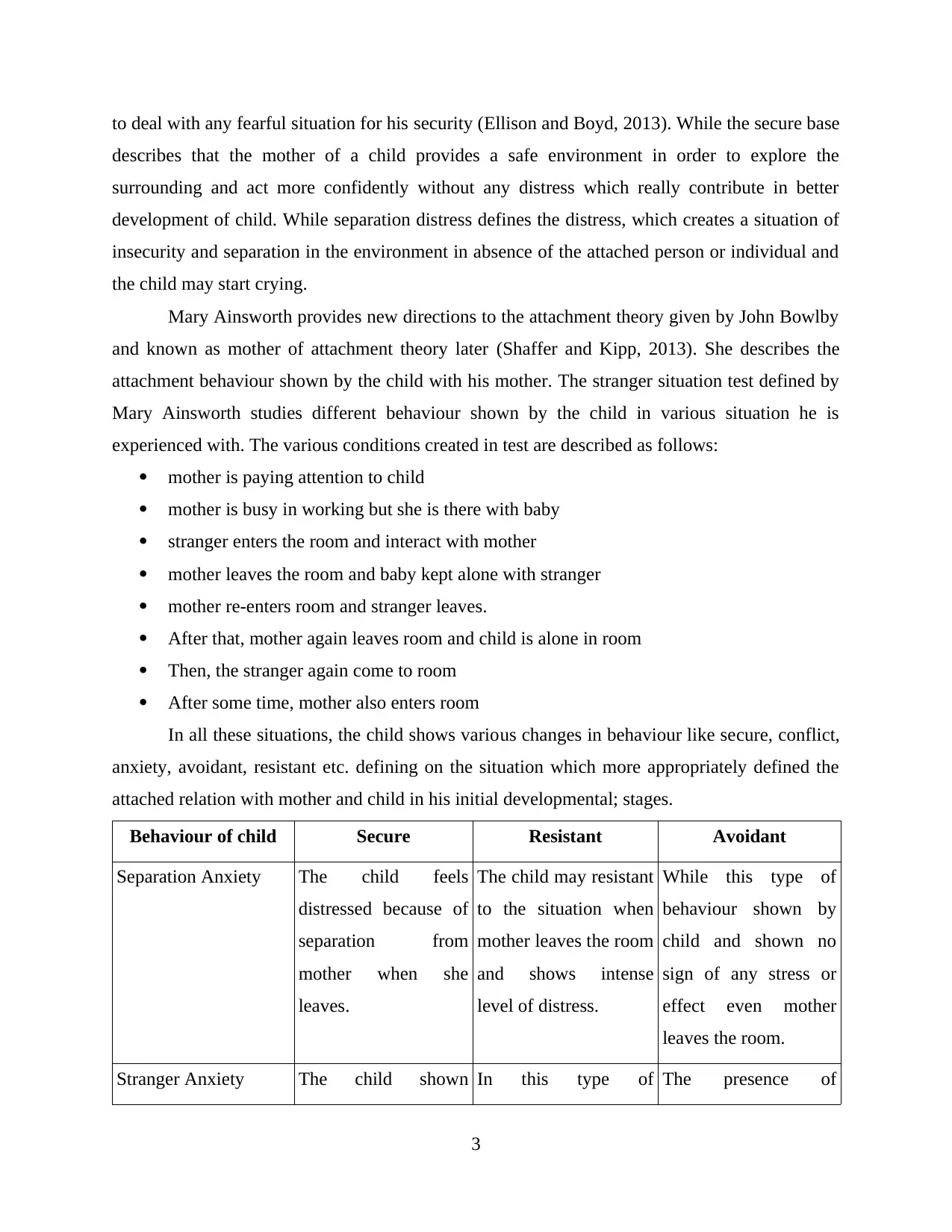
to deal with any fearful situation for his security (Ellison and Boyd, 2013). While the secure base
describes that the mother of a child provides a safe environment in order to explore the
surrounding and act more confidently without any distress which really contribute in better
development of child. While separation distress defines the distress, which creates a situation of
insecurity and separation in the environment in absence of the attached person or individual and
the child may start crying.
Mary Ainsworth provides new directions to the attachment theory given by John Bowlby
and known as mother of attachment theory later (Shaffer and Kipp, 2013). She describes the
attachment behaviour shown by the child with his mother. The stranger situation test defined by
Mary Ainsworth studies different behaviour shown by the child in various situation he is
experienced with. The various conditions created in test are described as follows:
mother is paying attention to child
mother is busy in working but she is there with baby
stranger enters the room and interact with mother
mother leaves the room and baby kept alone with stranger
mother re-enters room and stranger leaves.
After that, mother again leaves room and child is alone in room
Then, the stranger again come to room
After some time, mother also enters room
In all these situations, the child shows various changes in behaviour like secure, conflict,
anxiety, avoidant, resistant etc. defining on the situation which more appropriately defined the
attached relation with mother and child in his initial developmental; stages.
Behaviour of child Secure Resistant Avoidant
Separation Anxiety The child feels
distressed because of
separation from
mother when she
leaves.
The child may resistant
to the situation when
mother leaves the room
and shows intense
level of distress.
While this type of
behaviour shown by
child and shown no
sign of any stress or
effect even mother
leaves the room.
Stranger Anxiety The child shown In this type of The presence of
3
describes that the mother of a child provides a safe environment in order to explore the
surrounding and act more confidently without any distress which really contribute in better
development of child. While separation distress defines the distress, which creates a situation of
insecurity and separation in the environment in absence of the attached person or individual and
the child may start crying.
Mary Ainsworth provides new directions to the attachment theory given by John Bowlby
and known as mother of attachment theory later (Shaffer and Kipp, 2013). She describes the
attachment behaviour shown by the child with his mother. The stranger situation test defined by
Mary Ainsworth studies different behaviour shown by the child in various situation he is
experienced with. The various conditions created in test are described as follows:
mother is paying attention to child
mother is busy in working but she is there with baby
stranger enters the room and interact with mother
mother leaves the room and baby kept alone with stranger
mother re-enters room and stranger leaves.
After that, mother again leaves room and child is alone in room
Then, the stranger again come to room
After some time, mother also enters room
In all these situations, the child shows various changes in behaviour like secure, conflict,
anxiety, avoidant, resistant etc. defining on the situation which more appropriately defined the
attached relation with mother and child in his initial developmental; stages.
Behaviour of child Secure Resistant Avoidant
Separation Anxiety The child feels
distressed because of
separation from
mother when she
leaves.
The child may resistant
to the situation when
mother leaves the room
and shows intense
level of distress.
While this type of
behaviour shown by
child and shown no
sign of any stress or
effect even mother
leaves the room.
Stranger Anxiety The child shown In this type of The presence of
3
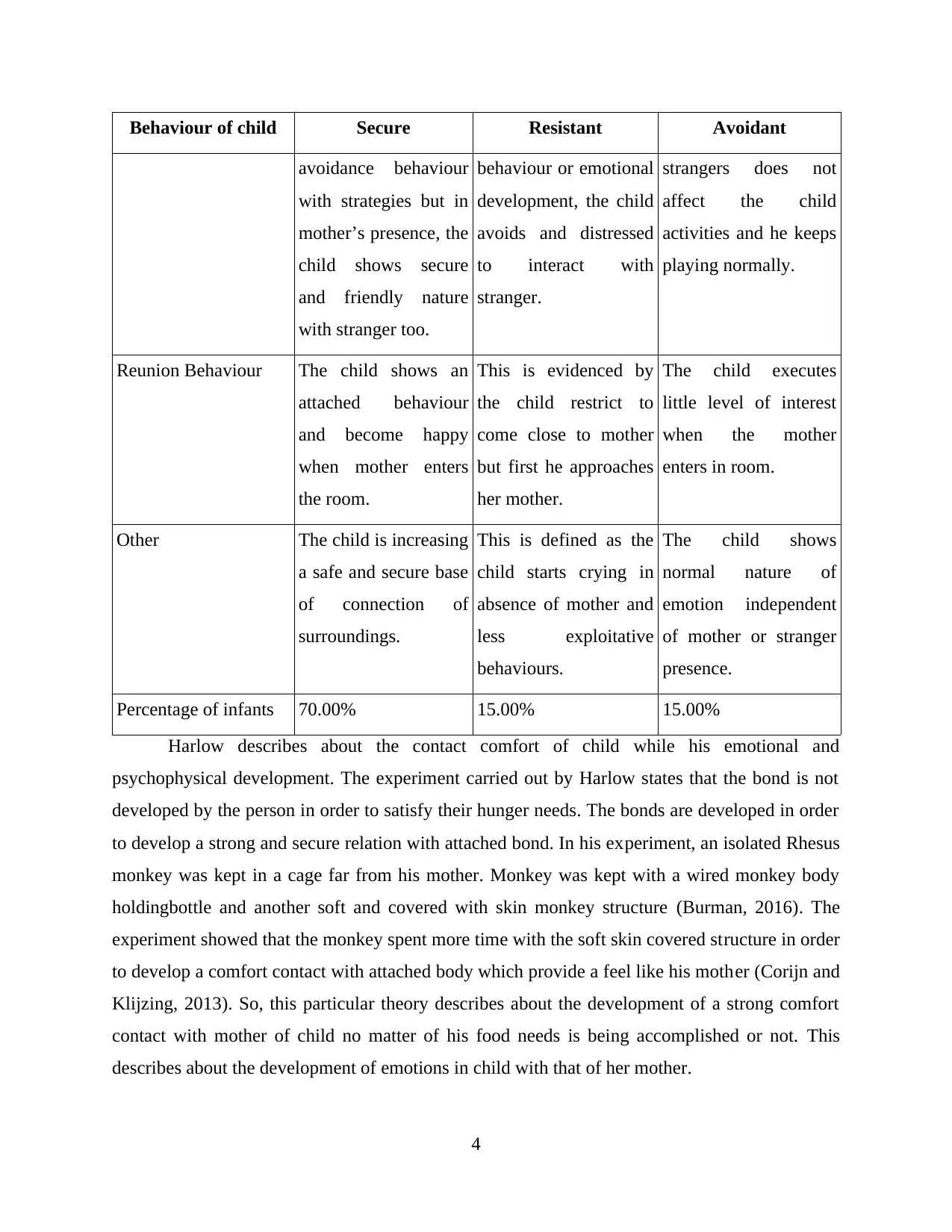
Behaviour of child Secure Resistant Avoidant
avoidance behaviour
with strategies but in
mother’s presence, the
child shows secure
and friendly nature
with stranger too.
behaviour or emotional
development, the child
avoids and distressed
to interact with
stranger.
strangers does not
affect the child
activities and he keeps
playing normally.
Reunion Behaviour The child shows an
attached behaviour
and become happy
when mother enters
the room.
This is evidenced by
the child restrict to
come close to mother
but first he approaches
her mother.
The child executes
little level of interest
when the mother
enters in room.
Other The child is increasing
a safe and secure base
of connection of
surroundings.
This is defined as the
child starts crying in
absence of mother and
less exploitative
behaviours.
The child shows
normal nature of
emotion independent
of mother or stranger
presence.
Percentage of infants 70.00% 15.00% 15.00%
Harlow describes about the contact comfort of child while his emotional and
psychophysical development. The experiment carried out by Harlow states that the bond is not
developed by the person in order to satisfy their hunger needs. The bonds are developed in order
to develop a strong and secure relation with attached bond. In his experiment, an isolated Rhesus
monkey was kept in a cage far from his mother. Monkey was kept with a wired monkey body
holdingbottle and another soft and covered with skin monkey structure (Burman, 2016). The
experiment showed that the monkey spent more time with the soft skin covered structure in order
to develop a comfort contact with attached body which provide a feel like his mother (Corijn and
Klijzing, 2013). So, this particular theory describes about the development of a strong comfort
contact with mother of child no matter of his food needs is being accomplished or not. This
describes about the development of emotions in child with that of her mother.
4
avoidance behaviour
with strategies but in
mother’s presence, the
child shows secure
and friendly nature
with stranger too.
behaviour or emotional
development, the child
avoids and distressed
to interact with
stranger.
strangers does not
affect the child
activities and he keeps
playing normally.
Reunion Behaviour The child shows an
attached behaviour
and become happy
when mother enters
the room.
This is evidenced by
the child restrict to
come close to mother
but first he approaches
her mother.
The child executes
little level of interest
when the mother
enters in room.
Other The child is increasing
a safe and secure base
of connection of
surroundings.
This is defined as the
child starts crying in
absence of mother and
less exploitative
behaviours.
The child shows
normal nature of
emotion independent
of mother or stranger
presence.
Percentage of infants 70.00% 15.00% 15.00%
Harlow describes about the contact comfort of child while his emotional and
psychophysical development. The experiment carried out by Harlow states that the bond is not
developed by the person in order to satisfy their hunger needs. The bonds are developed in order
to develop a strong and secure relation with attached bond. In his experiment, an isolated Rhesus
monkey was kept in a cage far from his mother. Monkey was kept with a wired monkey body
holdingbottle and another soft and covered with skin monkey structure (Burman, 2016). The
experiment showed that the monkey spent more time with the soft skin covered structure in order
to develop a comfort contact with attached body which provide a feel like his mother (Corijn and
Klijzing, 2013). So, this particular theory describes about the development of a strong comfort
contact with mother of child no matter of his food needs is being accomplished or not. This
describes about the development of emotions in child with that of her mother.
4
You're viewing a preview
Unlock full access by subscribing today!
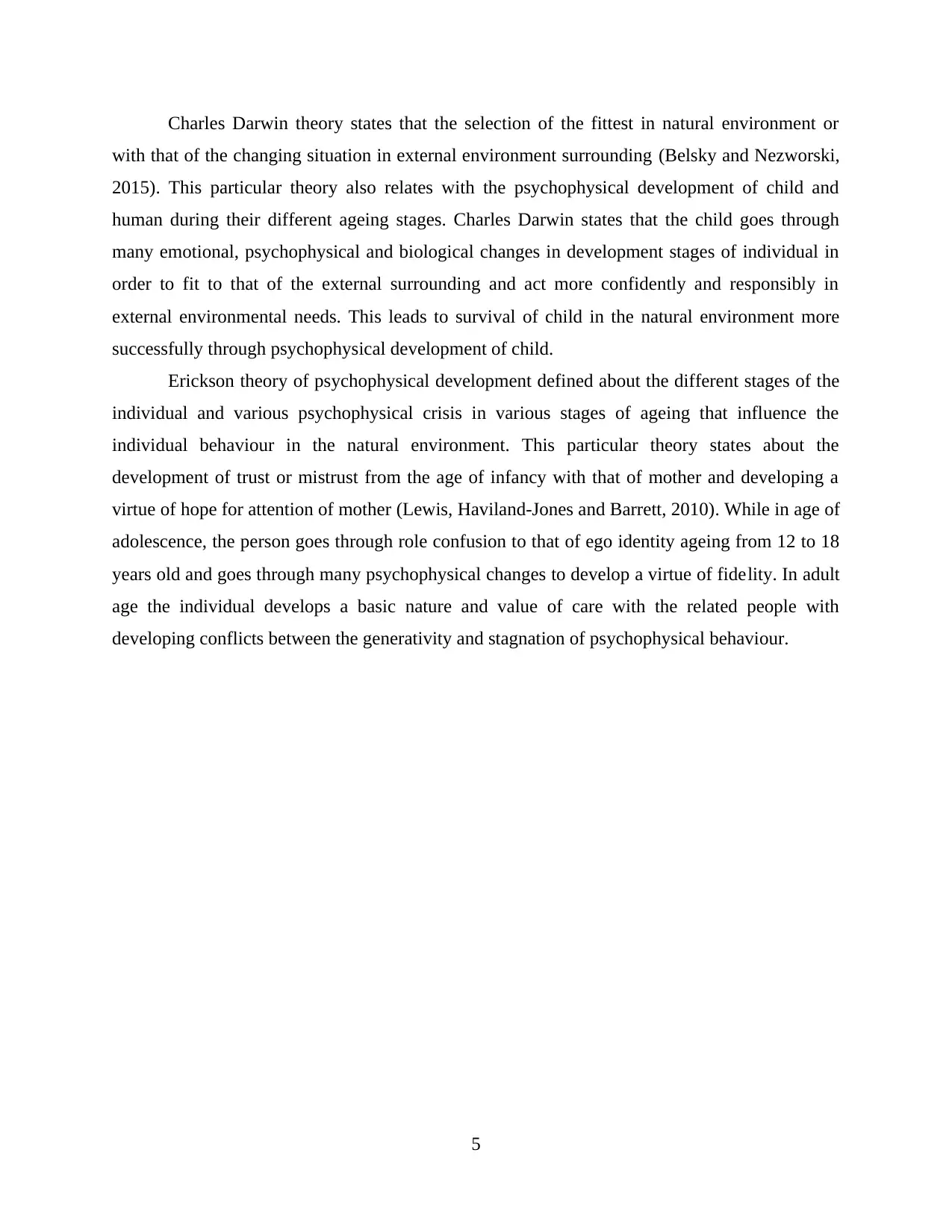
Charles Darwin theory states that the selection of the fittest in natural environment or
with that of the changing situation in external environment surrounding (Belsky and Nezworski,
2015). This particular theory also relates with the psychophysical development of child and
human during their different ageing stages. Charles Darwin states that the child goes through
many emotional, psychophysical and biological changes in development stages of individual in
order to fit to that of the external surrounding and act more confidently and responsibly in
external environmental needs. This leads to survival of child in the natural environment more
successfully through psychophysical development of child.
Erickson theory of psychophysical development defined about the different stages of the
individual and various psychophysical crisis in various stages of ageing that influence the
individual behaviour in the natural environment. This particular theory states about the
development of trust or mistrust from the age of infancy with that of mother and developing a
virtue of hope for attention of mother (Lewis, Haviland-Jones and Barrett, 2010). While in age of
adolescence, the person goes through role confusion to that of ego identity ageing from 12 to 18
years old and goes through many psychophysical changes to develop a virtue of fidelity. In adult
age the individual develops a basic nature and value of care with the related people with
developing conflicts between the generativity and stagnation of psychophysical behaviour.
5
with that of the changing situation in external environment surrounding (Belsky and Nezworski,
2015). This particular theory also relates with the psychophysical development of child and
human during their different ageing stages. Charles Darwin states that the child goes through
many emotional, psychophysical and biological changes in development stages of individual in
order to fit to that of the external surrounding and act more confidently and responsibly in
external environmental needs. This leads to survival of child in the natural environment more
successfully through psychophysical development of child.
Erickson theory of psychophysical development defined about the different stages of the
individual and various psychophysical crisis in various stages of ageing that influence the
individual behaviour in the natural environment. This particular theory states about the
development of trust or mistrust from the age of infancy with that of mother and developing a
virtue of hope for attention of mother (Lewis, Haviland-Jones and Barrett, 2010). While in age of
adolescence, the person goes through role confusion to that of ego identity ageing from 12 to 18
years old and goes through many psychophysical changes to develop a virtue of fidelity. In adult
age the individual develops a basic nature and value of care with the related people with
developing conflicts between the generativity and stagnation of psychophysical behaviour.
5
Paraphrase This Document
Need a fresh take? Get an instant paraphrase of this document with our AI Paraphraser
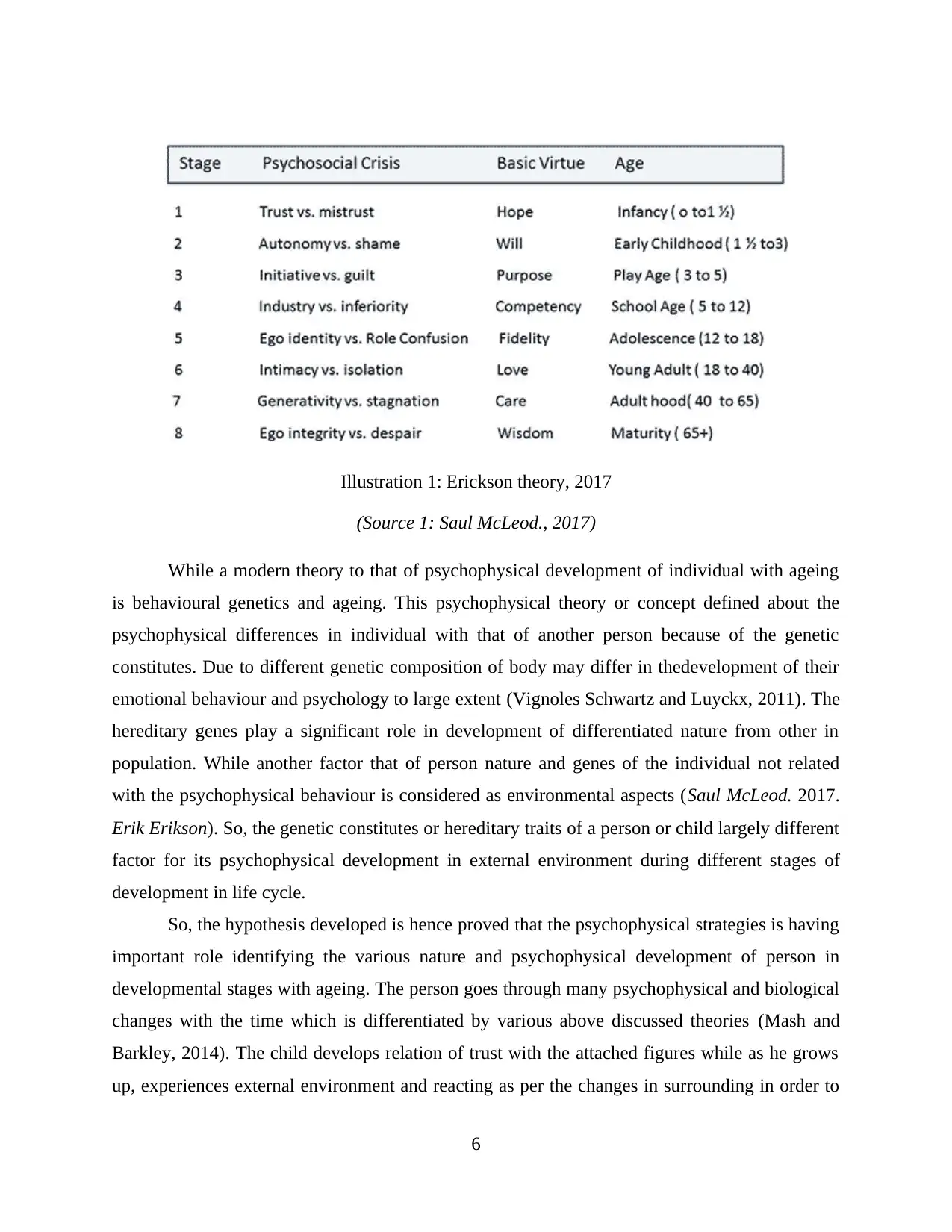
While a modern theory to that of psychophysical development of individual with ageing
is behavioural genetics and ageing. This psychophysical theory or concept defined about the
psychophysical differences in individual with that of another person because of the genetic
constitutes. Due to different genetic composition of body may differ in thedevelopment of their
emotional behaviour and psychology to large extent (Vignoles Schwartz and Luyckx, 2011). The
hereditary genes play a significant role in development of differentiated nature from other in
population. While another factor that of person nature and genes of the individual not related
with the psychophysical behaviour is considered as environmental aspects (Saul McLeod. 2017.
Erik Erikson). So, the genetic constitutes or hereditary traits of a person or child largely different
factor for its psychophysical development in external environment during different stages of
development in life cycle.
So, the hypothesis developed is hence proved that the psychophysical strategies is having
important role identifying the various nature and psychophysical development of person in
developmental stages with ageing. The person goes through many psychophysical and biological
changes with the time which is differentiated by various above discussed theories (Mash and
Barkley, 2014). The child develops relation of trust with the attached figures while as he grows
up, experiences external environment and reacting as per the changes in surrounding in order to
6
Illustration 1: Erickson theory, 2017
(Source 1: Saul McLeod., 2017)
is behavioural genetics and ageing. This psychophysical theory or concept defined about the
psychophysical differences in individual with that of another person because of the genetic
constitutes. Due to different genetic composition of body may differ in thedevelopment of their
emotional behaviour and psychology to large extent (Vignoles Schwartz and Luyckx, 2011). The
hereditary genes play a significant role in development of differentiated nature from other in
population. While another factor that of person nature and genes of the individual not related
with the psychophysical behaviour is considered as environmental aspects (Saul McLeod. 2017.
Erik Erikson). So, the genetic constitutes or hereditary traits of a person or child largely different
factor for its psychophysical development in external environment during different stages of
development in life cycle.
So, the hypothesis developed is hence proved that the psychophysical strategies is having
important role identifying the various nature and psychophysical development of person in
developmental stages with ageing. The person goes through many psychophysical and biological
changes with the time which is differentiated by various above discussed theories (Mash and
Barkley, 2014). The child develops relation of trust with the attached figures while as he grows
up, experiences external environment and reacting as per the changes in surrounding in order to
6
Illustration 1: Erickson theory, 2017
(Source 1: Saul McLeod., 2017)
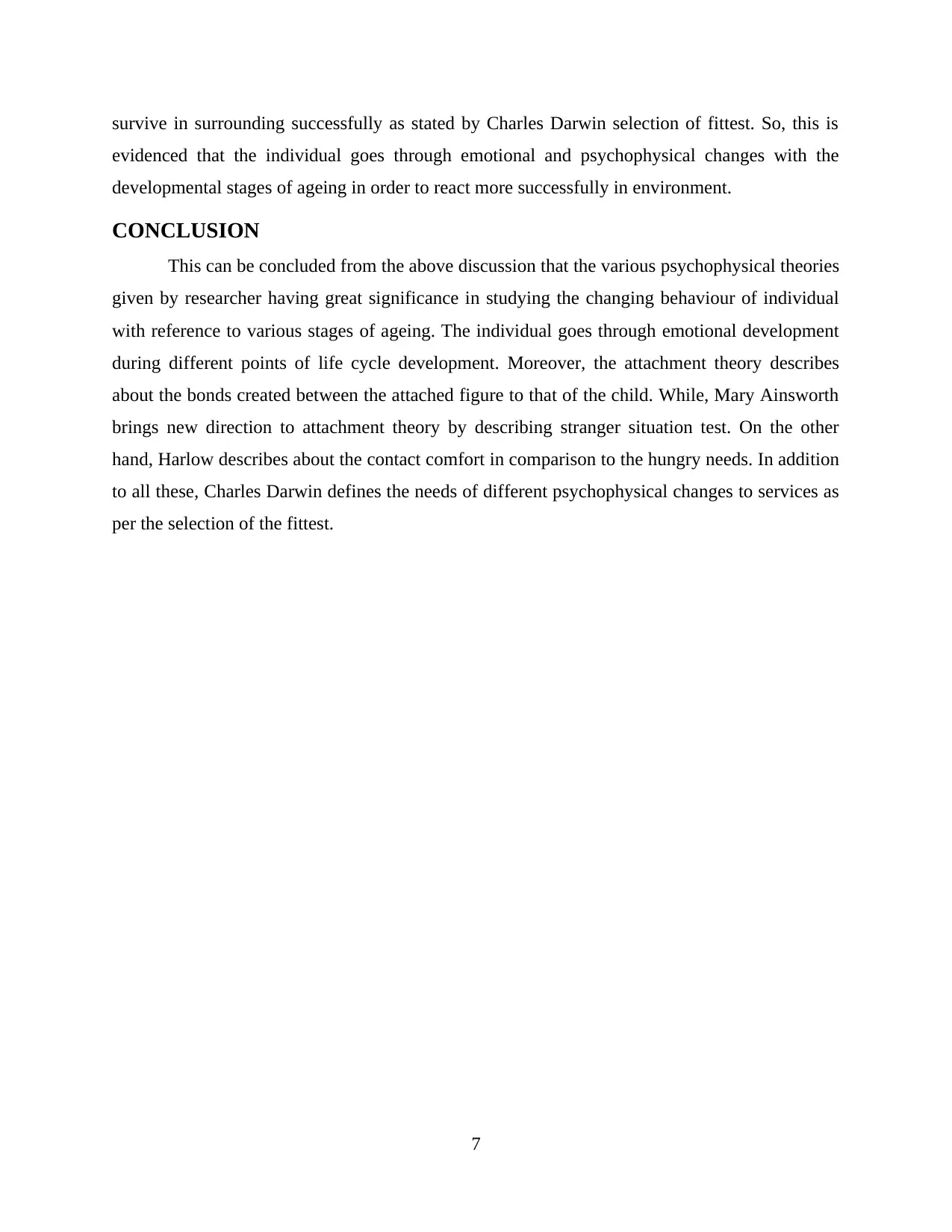
survive in surrounding successfully as stated by Charles Darwin selection of fittest. So, this is
evidenced that the individual goes through emotional and psychophysical changes with the
developmental stages of ageing in order to react more successfully in environment.
CONCLUSION
This can be concluded from the above discussion that the various psychophysical theories
given by researcher having great significance in studying the changing behaviour of individual
with reference to various stages of ageing. The individual goes through emotional development
during different points of life cycle development. Moreover, the attachment theory describes
about the bonds created between the attached figure to that of the child. While, Mary Ainsworth
brings new direction to attachment theory by describing stranger situation test. On the other
hand, Harlow describes about the contact comfort in comparison to the hungry needs. In addition
to all these, Charles Darwin defines the needs of different psychophysical changes to services as
per the selection of the fittest.
7
evidenced that the individual goes through emotional and psychophysical changes with the
developmental stages of ageing in order to react more successfully in environment.
CONCLUSION
This can be concluded from the above discussion that the various psychophysical theories
given by researcher having great significance in studying the changing behaviour of individual
with reference to various stages of ageing. The individual goes through emotional development
during different points of life cycle development. Moreover, the attachment theory describes
about the bonds created between the attached figure to that of the child. While, Mary Ainsworth
brings new direction to attachment theory by describing stranger situation test. On the other
hand, Harlow describes about the contact comfort in comparison to the hungry needs. In addition
to all these, Charles Darwin defines the needs of different psychophysical changes to services as
per the selection of the fittest.
7
You're viewing a preview
Unlock full access by subscribing today!
1 out of 9
Related Documents
Your All-in-One AI-Powered Toolkit for Academic Success.
+13062052269
info@desklib.com
Available 24*7 on WhatsApp / Email
![[object Object]](/_next/static/media/star-bottom.7253800d.svg)
Unlock your academic potential
© 2024 | Zucol Services PVT LTD | All rights reserved.





